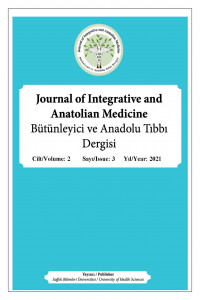Hematolojik Maligniteli Hastalar Arasında Tamamlayıcı ve Alternatif Tıp Kullanımının Değerlendirilmesi
Abstract
Tamamlayıcı ve alternatif tıp (TAT) onkoloji hastaları arasında giderek daha fazla kullanılmaktadır. Literatürde, hematolojik malignitr (HM) hastalarının TAT kullanımı ile ilgili çalışmalar az oranda bulunmaktadır. Bir grup Türk HM hastasında, TAT kullanımını çok parametreli bir yaklaşımla değerlendirmeyi ve kullanımı ile ilişkili demografik ve klinik faktörleri belirlemeyi amaçladık. Gerekli nitelikleri taşıyan 351 hastanın katılımı ile ayakta tedavi polikliniklerinde tanımlayıcı ve kesitsel bir çalışma gerçekleştirildi. Hastalara katılımcıların CAM'a (HCAMQ) karşı tutumlarını ve ayrıntılı CAM kullanımının birçok yönünü değerlendiren iki anket uygulandı. TAT kullanım sıklığı%70,1 idi ve en yaygın TAT yöntemleri arasında fitoterapi (%65), vitamin takviyesi ve ruhsal aktivite/dua yer almaktaydı. İstatistiksel analiz sonuçları, CAM kullanım oranının anlamlı olarak düşük ECOG performansları (p=0,016) ve düşük HCAMQ skorları (p <0,001) ile ilişkili olduğunu gösterdi. Ozon tedavisi kullanımı ileri yaş (p=0,042) ve yüksek ECOG performans skoru (p= 0,038) ile anlamlı olarak ilişkili idi. Hacamat kullanımı ilkokul mezunlarında (p=0,033), kemoterapi almayanlarda (p<0,001) ve yüksek riskli malignite durumları olanlarda (p<0,001) anlamlı olarak daha fazlaydı. Apiterapi ve sülük tedavisi kullanımlarının yüksek riskli malignite durumları ile anlamlı olarak ilişkili olduğunu bulduk (sırasıyla p=0,011 ve p=0,004). Sosyal medyanın fitoterapi (p=0.016), Nigella Sativa (p=0.007) ve Gingko biloba (p=0.026) ve TV / gazetenin Curcuma Longa için (p=0.018) birincil bilgi kaynağı olduğu bulundu.HM hastalarında TAT kullanımının yüksek sıklıkta olduğunu bulduk ve bizim kapsamlı araştırmamızın literatüre katkıda bulunacağını ve daha ileri ve daha büyük çalışmalara örnek olacağını bekliyoruz.
References
- 1. Bray F, Ferlay J, Soerjomataram I, Siegel RL, Torre LA, Jemal A. Global cancer statistics 2018: GLOBOCAN estimates of incidence and mortality worldwide for 36 cancers in 185 countries. CA Cancer J Clin. 2018;68:394-424.
- 2. Okolo ON, Gowin K. Emerging Role of Integrative Medicine in Hematologic Malignancies: a Literature Review and Update on Current Trends in Complementary Medical Practices in Hematologic Cancers. Curr Hematol Malig Rep. 2019;14:328-336.
The Assessment of Complementary and Alternative Medicine Use Among Patients with Hematological Malignancies
Abstract
Complementary and alternative medicine (CAM) is increasingly used among oncology patients. In the literature, the studies on hematological malignancy (HM) patients’ use of CAM are scarce. We aimed to assess CAM use in a group of Turkish HM patients by a multi-parameter approach and determine the demographic and clinical factors associated with its use. This descriptive and cross-sectional study was conducted in the outpatient clinics with 351 eligible patients. Two questionnaires, one of which assessed the attitudes of participants to CAM (HCAMQ), and the other detailed multiple aspects of CAM use, were applied. The frequency of CAM use was 70.1% and, among the most common CAM methods, were phytotherapy (65%), vitamin supplementation, and spiritual activity/prayer. The statistical analysis results showed that the rate of CAM use was significantly associated with lower ECOG performances (p:0.016) and lower HCAMQ scores (p<0.001). Using Ozone therapy was significantly associated with older age (p:0.042) and higher ECOG performance score (p:0.038) while hijama use was significantly more in the graduates of elementary school (p:0.033), and in the patients who did not undergo chemotherapy (p<0.001) and who had high-risk/malignant conditions (p<0.001). We found that apitherapy and leech therapy uses were significantly associated with high-risk/malignant conditions (p:0.011 and p:0.004, respectively). Social media was found as the primary source of information for phytotherapy (p:0.016), Nigella Sativa (p:0.007), and Gingko biloba (p:0.026) while TV/newspaper was so for Curcuma Longa (p:0.018). We found a high frequency of CAM use among HM patients, and we expect that our comprehensive research will contribute to the literature, and set an example for further and larger studies.
Keywords
Complementary and alternative medicine Hematologic malignancies Phytotherapy Curcuma Longa Urtica Dioica
References
- 1. Bray F, Ferlay J, Soerjomataram I, Siegel RL, Torre LA, Jemal A. Global cancer statistics 2018: GLOBOCAN estimates of incidence and mortality worldwide for 36 cancers in 185 countries. CA Cancer J Clin. 2018;68:394-424.
- 2. Okolo ON, Gowin K. Emerging Role of Integrative Medicine in Hematologic Malignancies: a Literature Review and Update on Current Trends in Complementary Medical Practices in Hematologic Cancers. Curr Hematol Malig Rep. 2019;14:328-336.
Details
| Primary Language | English |
|---|---|
| Subjects | Clinical Sciences |
| Journal Section | Research Articles |
| Authors | |
| Publication Date | October 24, 2021 |
| Published in Issue | Year 2021 Volume: 2 Issue: 3 |
◆◆◆
◆◆◆




